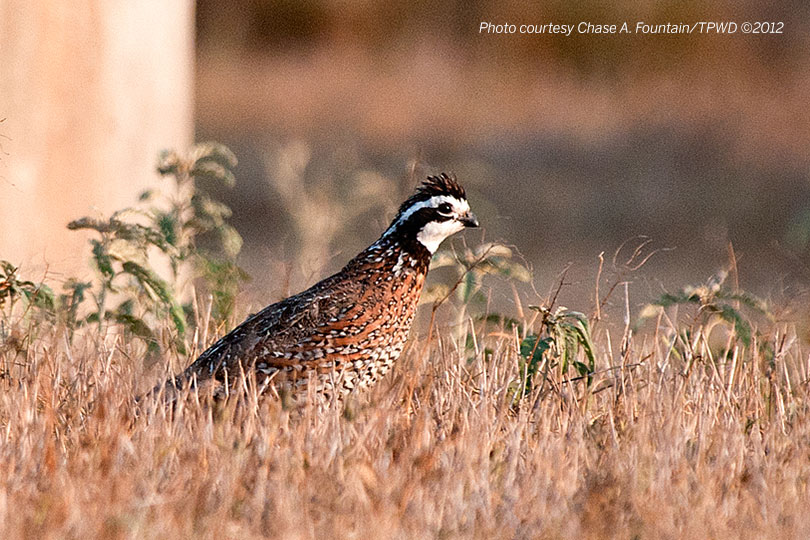By Jessica Domel
Multimedia Reporter
A generous gift from a Dallas native will help ensure Texas Tech University’s Quail-Tech program is able to continue to study the state’s declining quail population and potential ways to address it.
The donation from Chuck Ribelin will help fund five-year projects across three departments in Texas Tech’s Davis College of Agricultural Sciences and Natural Resources.
“He’s a really passionate individual about quail, quail hunting, bird dogs and youth being involved in quail hunting. His favorite saying is he wants to see birds on the ground, and that’s what we’re about,” Dr. Brad Dabbert, the Burnett Foundation Endowed Professor of Quail Ecology in Davis College, said.
The Quail-Tech data-driven research program, run by Dabbert, looks at the current problems affecting quail, what tools that can be used to impact them and then examines the end data.
“We started in 2010 with a broad program spread across the whole Rolling Plains,” Dabbert said. “We had a system where we were working with a bunch of different ranches to look at a broad overview of quail management and what we could do to try to improve things. We did counts on those ranches for several years.”
The primary funding from Ribelin’s gift will go toward a project that will demonstrate the effectiveness of the Tall Timbers model to sustain the huntable bobwhite populations on the Rolling Plains.
“The major portion is for a very large five-year study on the Pitchfork Ranch. In this particular study, we’re using broadcast supplemental feeding,” Dabbert told the Texas Farm Bureau Radio Network.
In addition to the broadcast supplemental feeding, Quail-Tech will also use predator reduction on the ranch in Dickens County to determine which measures are most effective to sustain the bobwhite quail populations.
“Within that, we’re focusing on nest survival and chick survival as well,” Dabbert said. “That is a little bit of a black box, as far as the factors that affect chick survival.”
This is the second phase of the Quail-Tech research program.
“We really are a data-driven unit in that we are measuring the demographics. What is nest success? What is the chick survival? What is the density, or as Chuck likes to say, ‘How many birds are actually on the ground?’” Dabbert said. “We’re going to be, over the next few years, really working at tools that we can to do that.”
Quail-Tech’s research has already found that 85% of quail hens that had access to feed that is broadcast into their environment started at least one nest during the drought of 2011.
Only 15% of the quail that did not have access to the broadcast supplemental feed tried a single nest that year.
“You can see that severe drought pretty much wipes out a lot of nesting opportunities or nesting that occurs,” Dabbert said. “The problem in 2011 was that sorghum is a high energy food, but it’s a relatively low protein, and those growing chicks need really high protein.”
Even though hens were bringing their broods to the supplemental feeding area, it wasn’t a sufficient protein. Those chicks were not getting the body growth they needed, and chick survival was affected.
“That’s one of the ways that we try to look at the biological conditions that we see and make adjustments to that,” Dabbert said.
This year, Quail-Tech will try to utilize a brightly colored chick feed with the sorghum to hopefully enhance chick growth and survival.
“Creativity is what we’re going to have to have to solve a lot of these problems, especially with the potential for more frequent droughts,” Dabbert said.
In addition to advancing quail research, Ribelin’s gift to the university creates two funds for related research projects.
According to the university, the Chuck Ribelin Quail Ecology Public Awareness Support Fund will provide support for a student in the Picador Creative internship program in the Department of Agricultural Education and Communications to focus on promoting awareness of quail ecology.
“This fund allows one of our agricultural communications students the opportunity to expand the skills they learned in the classroom and apply those lessons to a real situation,” Erica Irlbeck, professor of agricultural communications and director of Picador Creative, said. “The students learn more about academic research, natural resources and quail specific to Texas, all while growing their communications portfolio.”
The Chuck Ribelin Economic Impact and Policy Advocacy of Quail Ecology Fund will support a graduate student in agricultural and applied economics to study the economic impact and policy advocacy for quail ecology.
“Quail hunting has traditionally been an important activity for the region and a good portion of the money comes from outside the region,” Darren Hudson, professor and the Larry Combest Endowed Chair in the Department of Agricultural and Applied Economics, said. “Our research will seek to quantify the regional economic impact of quail hunting and examine the impacts that increasing quail populations would have on regional economic activity. Combined with the effort in agricultural communications, our research will help inform regional businesses, researchers, and policy-makers about the value of investing in quail population improvement.”
Dabbert said there are plans to produce videos and other materials for the public using the research after the five-year project is completed.
Additional information on Quail-Tech is available at quail-tech.org.

